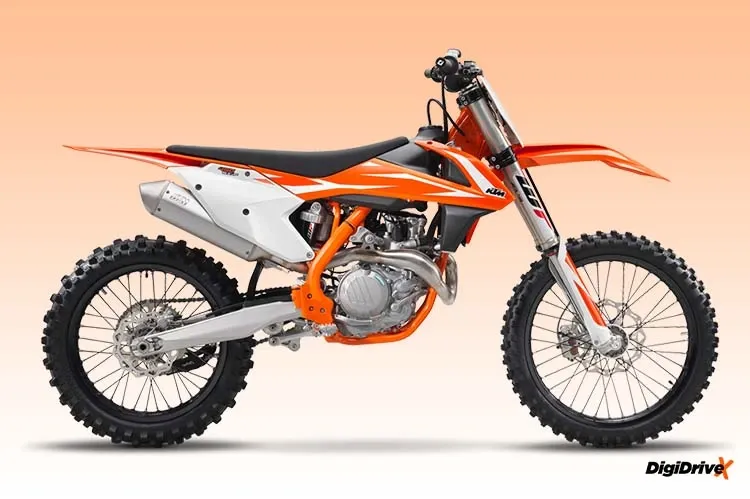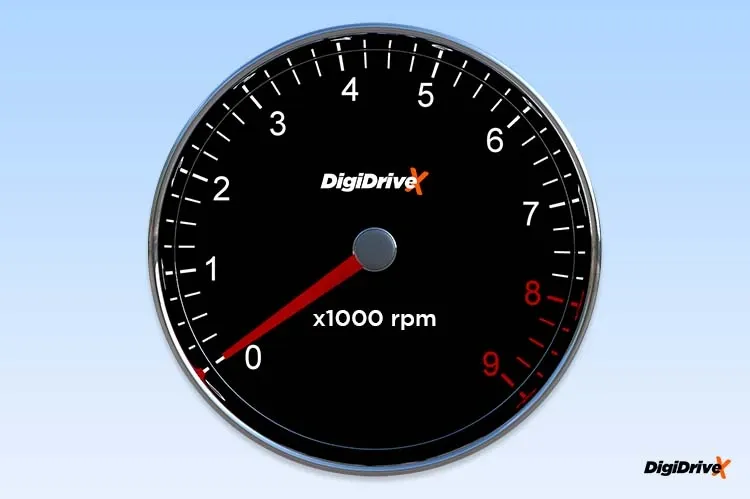(hideAds)
When riding a motorcycle, you’ve probably noticed the RPM gauge or tachometer, often prominently displayed on the dashboard. But What Is RPM In Bike, and why is it so important to understand how your motorcycle performs?
RPM, or Revolutions Per Minute, is a term used to measure how many times the engine's crankshaft completes one full rotation in a minute. This measurement plays a crucial role in how a motorcycle engine generates power and how it transfers that power to the wheels. Understanding What Is RPM In Bike and how it relates to engine performance, fuel efficiency, and rider control is fundamental for anyone looking to maximize their motorcycle's potential.
In this article We'll explore RPM in-depth,explaining its significance, the science behind it, and how different RPM ranges affect your riding experience.
What Is RPM In Bikes?
RPM stands for Revolutions Per Minute, and it refers to the number of full rotations the crankshaft in an engine completes in one minute. This measurement reflects the engine's rotational speed and helps riders understand how hard the engine is working at any given moment.
Crankshaft Movement: The crankshaft is responsible for turning the up-and-down motion of the engine's pistons into rotational motion, which powers the bike’s wheels.
Measurement of Engine Speed: The RPM indicates how fast the engine is spinning. For example, an engine running at 1,000 RPM means the crankshaft rotates 1,000 times per minute.
Tachometer: Most motorcycles have a tachometer, a gauge that shows the current RPM. This is an essential tool for riders to gauge the engine's performance and avoid over-revving.
Why Is RPM Important In Motorcycles?
RPM is one of the most critical factors in understanding a bike’s performance. It impacts everything from speed to fuel efficiency and engine health. Monitoring and understanding RPM helps riders optimize their performance and keep the engine running smoothly.
Key Reasons Why RPM Matters:
Power and Performance: RPM is directly tied to engine power output. At higher RPMs, the engine produces more power, which translates into faster speeds and greater acceleration.
Engine Efficiency: Maintaining the right RPM is key to maximizing fuel efficiency. Riding at excessively high RPMs burns more fuel, while staying in the optimal range allows for better fuel economy.
Prevention of Engine Damage: Over-revving, or pushing the engine beyond its redline RPM, can cause severe engine damage. Knowing the safe RPM range helps prevent overuse or engine strain.
How Does RPM Affect Motorcycle Performance?
Motorcycle engines work by burning a mixture of fuel and air in combustion chambers. The energy from this combustion pushes pistons, which move the crankshaft. RPM measures how fast this process happens, which has a direct effect on how the bike performs.
Key Factors Affected by RPM:
Power Band: RPM helps determine a bike’s "power band," which is the range of engine speeds where it performs best. Different bikes have different power bands based on their design.
Torque and RPM: Torque is the rotational force that causes the bike to accelerate. Torque is often higher at lower RPMs, allowing bikes to move quickly from a standstill. As RPM increases, power increases, but torque may drop.
Acceleration: The faster the engine spins (higher RPM), the faster the motorcycle accelerates. In this case, RPM becomes the primary driver of speed.
Gear Shifts: RPM tells the rider when to shift gears for optimal performance. Shifting at the correct RPM range ensures smooth gear transitions and prevents the engine from straining.
Optimal RPM Ranges for Different Types of Motorcycles
Different motorcycles are designed to operate within different RPM ranges. Knowing the optimal RPM range for your bike is crucial to achieving the best performance.
Sportbikes:
High RPM Engines: Sportbikes are designed for performance, with high-revving engines that can go up to 10,000-15,000 RPM. These bikes thrive at higher RPMs where they produce maximum power.
Acceleration: Sportbikes are tuned for sharp acceleration, which occurs when the engine revs higher, often above 7,000 RPM.
Cruisers:
Low to Mid RPM Range: Cruisers, such as Harley-Davidson motorcycles, are designed for relaxed riding, typically operating within a 2,000 to 6,000 RPM range.Power Delivery: These bikes emphasize torque over speed, delivering smooth power without the need for high RPMs.
Touring Bikes:
Balanced RPM: Touring bikes are designed to perform comfortably in a mid-RPM range but can handle higher RPMs for highway cruising. Typically, their RPM range hovers around 3,000 to 6,000 RPM, allowing for long rides at constant speeds without overworking the engine.
Dirt Bikes:
Variable RPM Range: Dirt bikes often feature engines that work best in the mid to high RPM range, depending on the riding conditions (off-road or racing). They need high RPM for quick bursts of speed but also require good low-end torque for navigating difficult terrains.
RPM, Gear Shifts, and Riding Techniques
The relationship between RPM and gear shifting is crucial for riding a motorcycle effectively. Knowing when to shift gears based on RPM helps in maximizing the bike’s performance while also preserving the engine.
How RPM Guides Gear Shifts:
Lower RPM for Initial Gears: In lower gears, RPM increases rapidly as the bike accelerates from a stop. As RPM rises, it’s a signal to shift to the next gear.
Higher RPM for Higher Gears: Once the bike is at a cruising speed, RPM stabilizes at lower values in higher gears, indicating the engine isn’t working as hard. Keeping the engine at a moderate RPM in high gears ensures smooth operation and efficiency.
Engine Braking: When slowing down, downshifting gears can help reduce RPM, allowing the engine to assist in braking. This is an essential technique for smoother deceleration and controlling the bike at slower speeds.
Common Gear-Shifting Mistakes:
Shifting Too Early: If you shift too early, when the RPM is still low, the engine may not generate enough power, causing it to lug. This results in slower acceleration and increased fuel consumption.
Shifting Too Late: Shifting too late, when the RPM is high, can cause unnecessary wear and tear on the engine and lead to over-revving.
The Relationship Between RPM and Fuel Efficiency
Riding at the correct RPM is not only essential for performance but also for fuel efficiency. Maintaining optimal RPM reduces fuel consumption and keeps your motorcycle running economically.
Fuel Consumption at Different RPMs:
Low RPM (Fuel Economy Mode): Riding at lower RPMs—typically between 2,000 and 4,000 saves fuel. The engine runs more efficiently, using less fuel to maintain speed.
High RPM (Performance Mode): When the engine operates at high RPMs, it burns more fuel to produce higher power. This is why aggressive riding and high-speed cruising often result in reduced fuel economy.
Balancing RPM for Best Efficiency:
To achieve the best fuel efficiency without sacrificing performance:
Cruise at a Steady RPM: On highways or long rides, maintaining a steady RPM between 3,000 and 5,000 is ideal for most bikes, depending on their design.
Avoid Over-Revving: Constantly pushing your bike to its limits with high RPM not only consumes more fuel but also shortens the life of the engine.
RPM and Engine Health
RPM plays a vital role in determining the health and longevity of a motorcycle engine. Constantly running the engine at extremely high RPMs, or “redlining,” can cause serious damage.
How Over-Revving Damages the Engine:
Excessive Heat: At very high RPMs, the engine generates excessive heat. Over time, this heat can cause the metal components inside the engine to wear down, leading to increased friction, warping, or even engine failure.
Component Stress: Parts such as pistons, crankshafts, and camshafts are under immense stress at high RPMs. Over time, they can wear out faster or break due to the added strain.
Best Practices for Engine Longevity:
Use the RPM Redline as a Limit: Each motorcycle has a redline, which marks the maximum RPM the engine can handle safely. Staying below this threshold ensures the engine runs without unnecessary strain.
Warm Up Your Engine: Always allow your bike to warm up before pushing it to higher RPMs. Cold engines are more susceptible to damage if revved too high before reaching optimal operating temperatures.
Regular Maintenance: Monitoring oil levels, replacing spark plugs, and ensuring the engine is properly tuned are all essential for keeping your bike’s RPM range functioning smoothly.
Understanding the Tachometer (RPM Gauge)
The tachometer is a vital tool for monitoring RPM. It’s typically displayed on the bike’s dashboard, showing the current RPM reading and indicating when the engine is operating efficiently.
How to Read a Tachometer:
RPM Numbers: The numbers on the tachometer represent revolutions per minute. For example, “1” on the dial represents 1,000 RPM.
Redline Indicator: The red section of the tachometer, often called the "redline," indicates the maximum safe RPM range for your bike.
Optimal Zone: The optimal RPM range for most motorcycles is somewhere between the low end (2,000-3,000 RPM) and the high end (6,000-8,000 RPM), depending on the bike type and engine size.
RPM in Different Riding Scenarios
RPM behaves differently depending on the terrain and the type of riding you’re doing. Understanding how to use RPM effectively in various riding conditions can improve performance and rider control.
City Riding:
Lower RPM: In stop-and-go traffic, keeping the RPM between 2,000 and 4,000 ensures smooth acceleration without unnecessary fuel consumption.
Frequent Gear Shifts: Expect to shift gears often as you navigate traffic, using RPM as a guide to prevent overworking the engine.
Highway Riding:
Steady RPM: On highways, maintaining an RPM between 4,000 and 6,000 provides the right balance of speed and fuel efficiency.
High Gear: In higher gears, RPM will drop, allowing for smoother and more efficient long-distance travel.
Off-Road Riding:
Variable RPM: Off-road riding may require a wider range of RPMs. You may need higher RPMs for quick acceleration in challenging terrain but lower RPMs for navigating obstacles.









